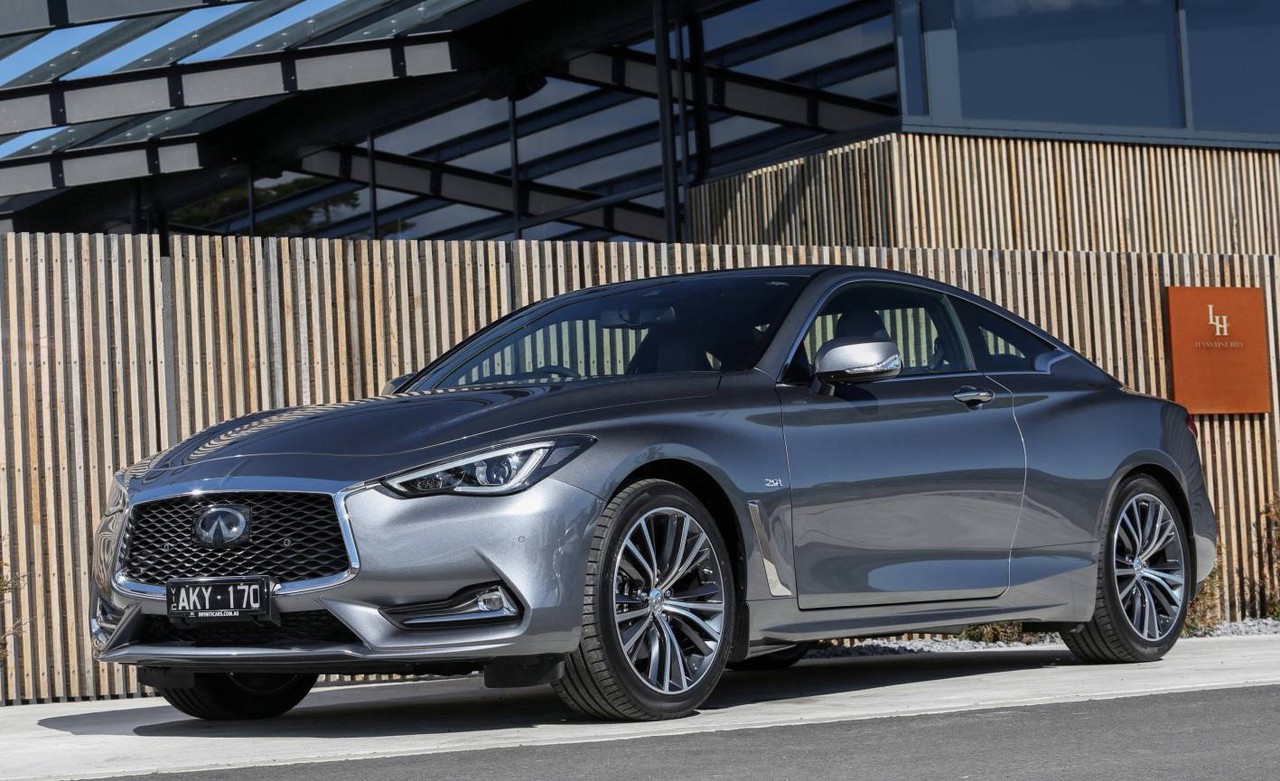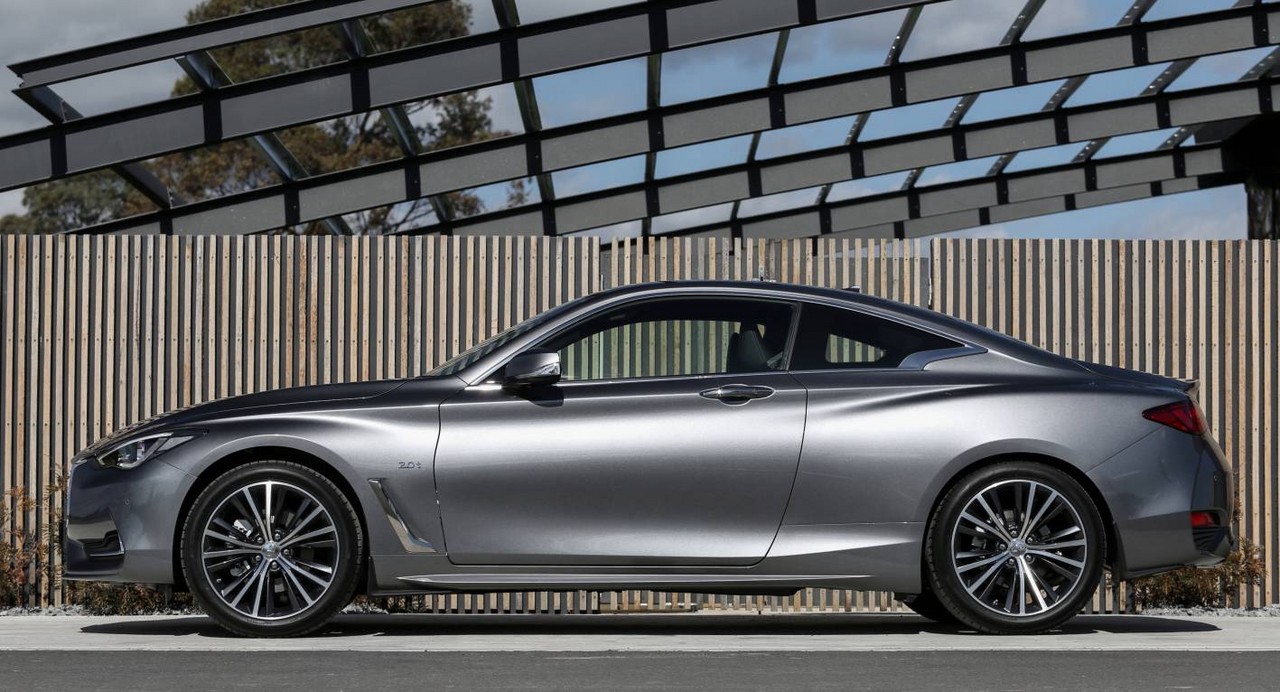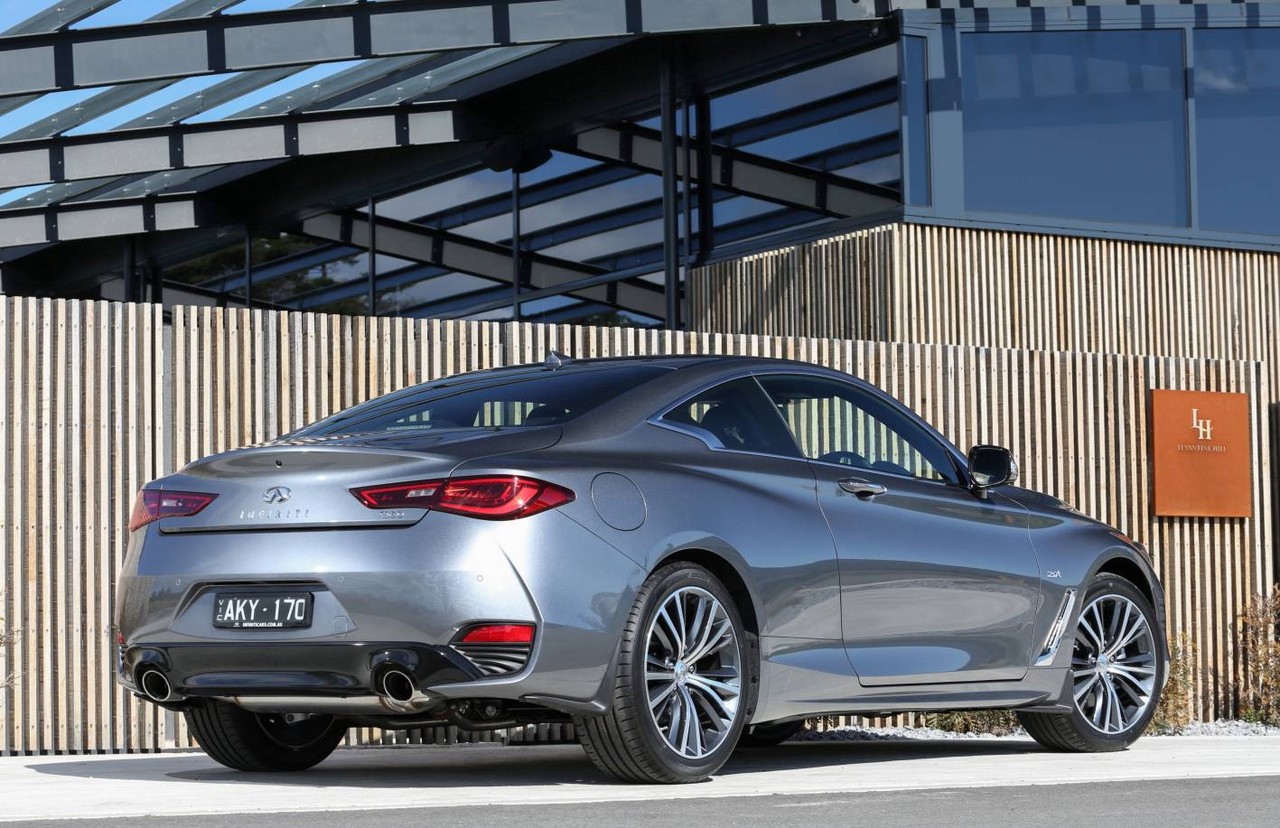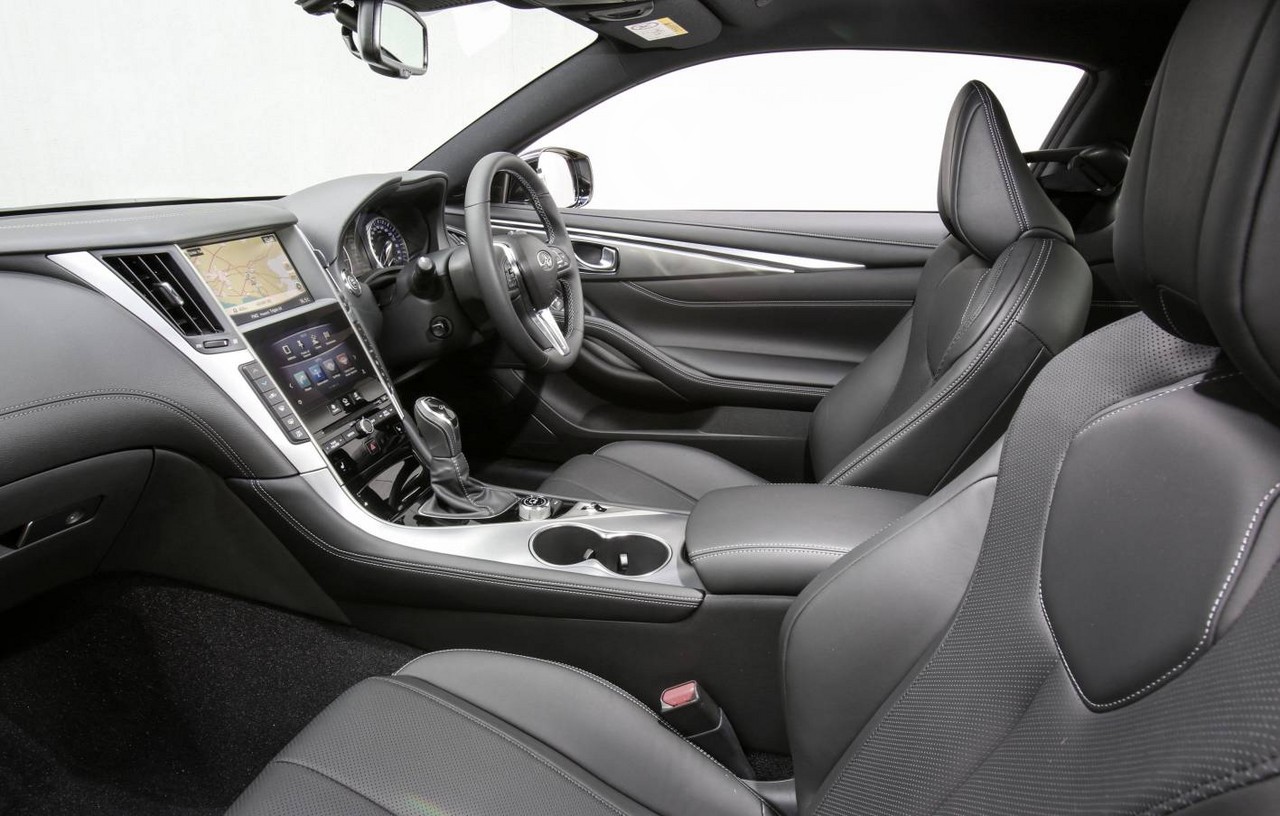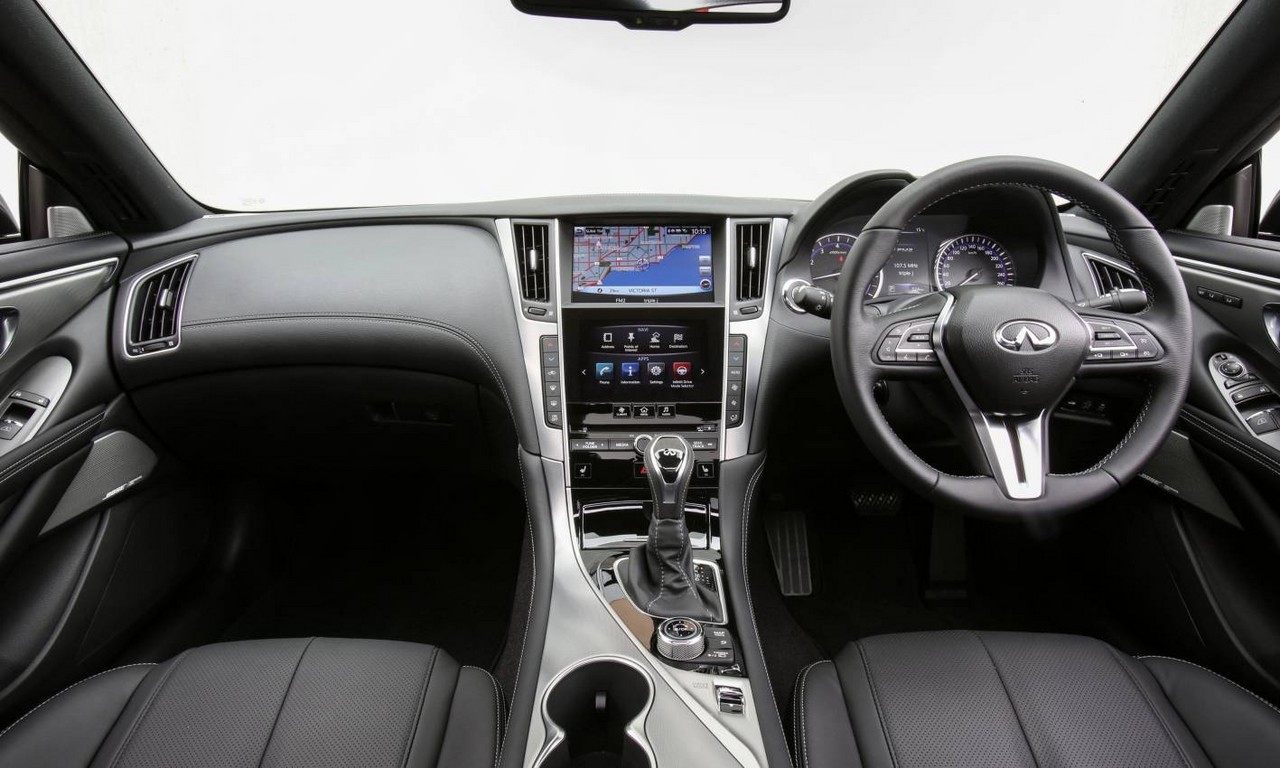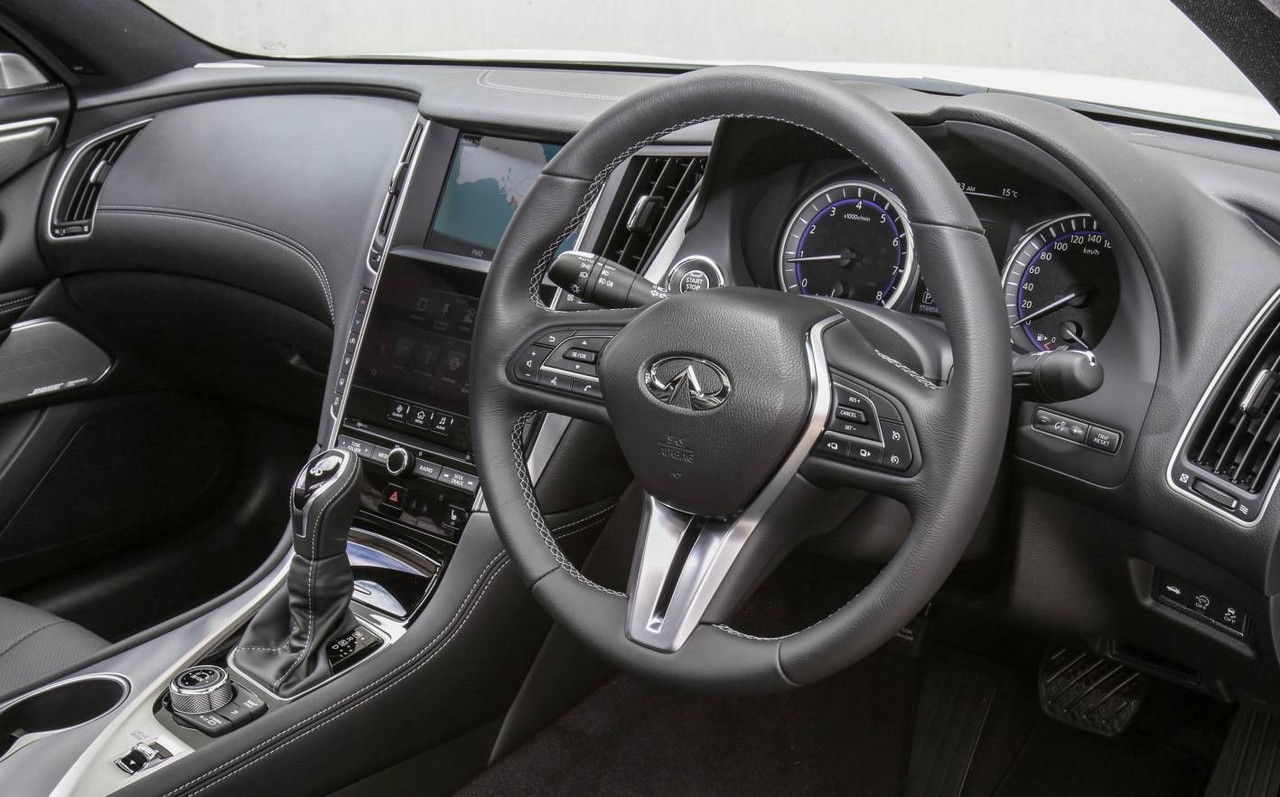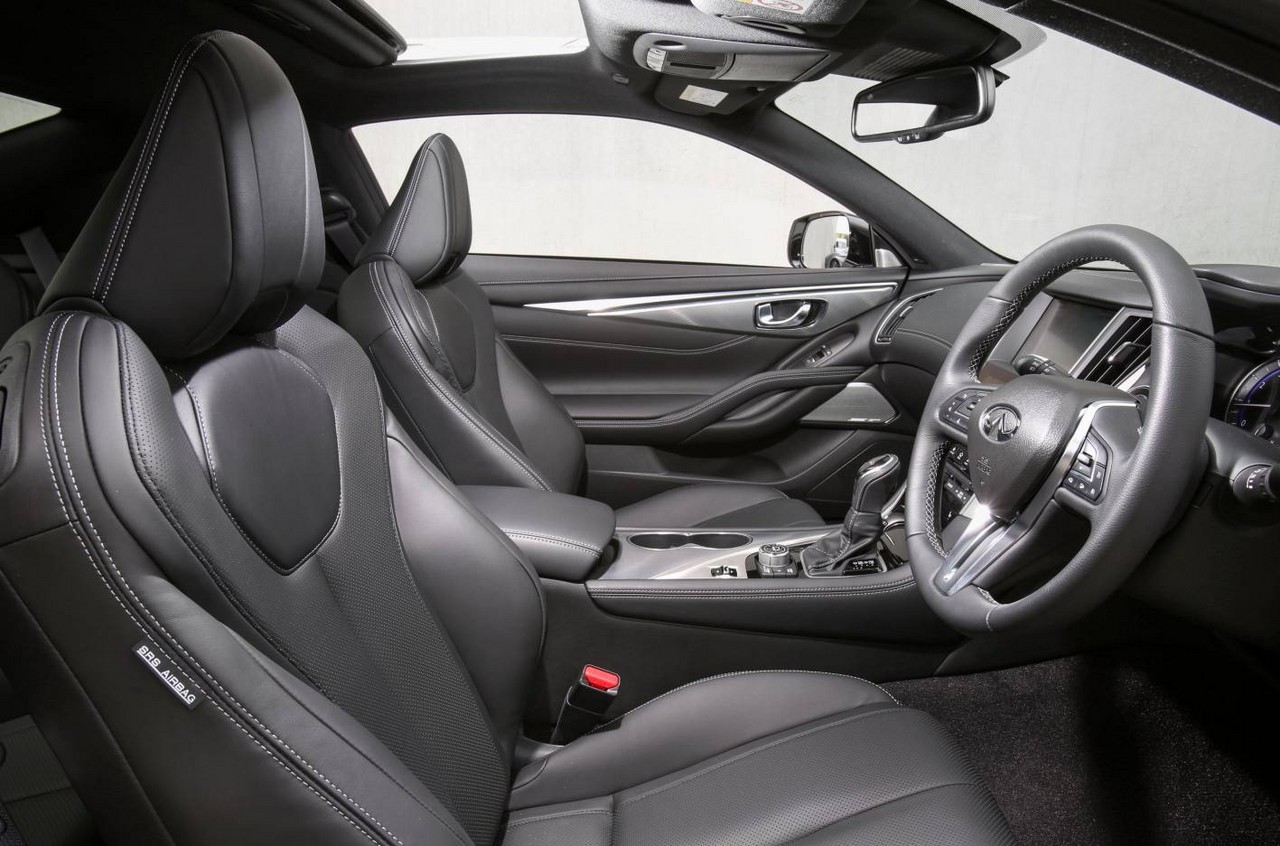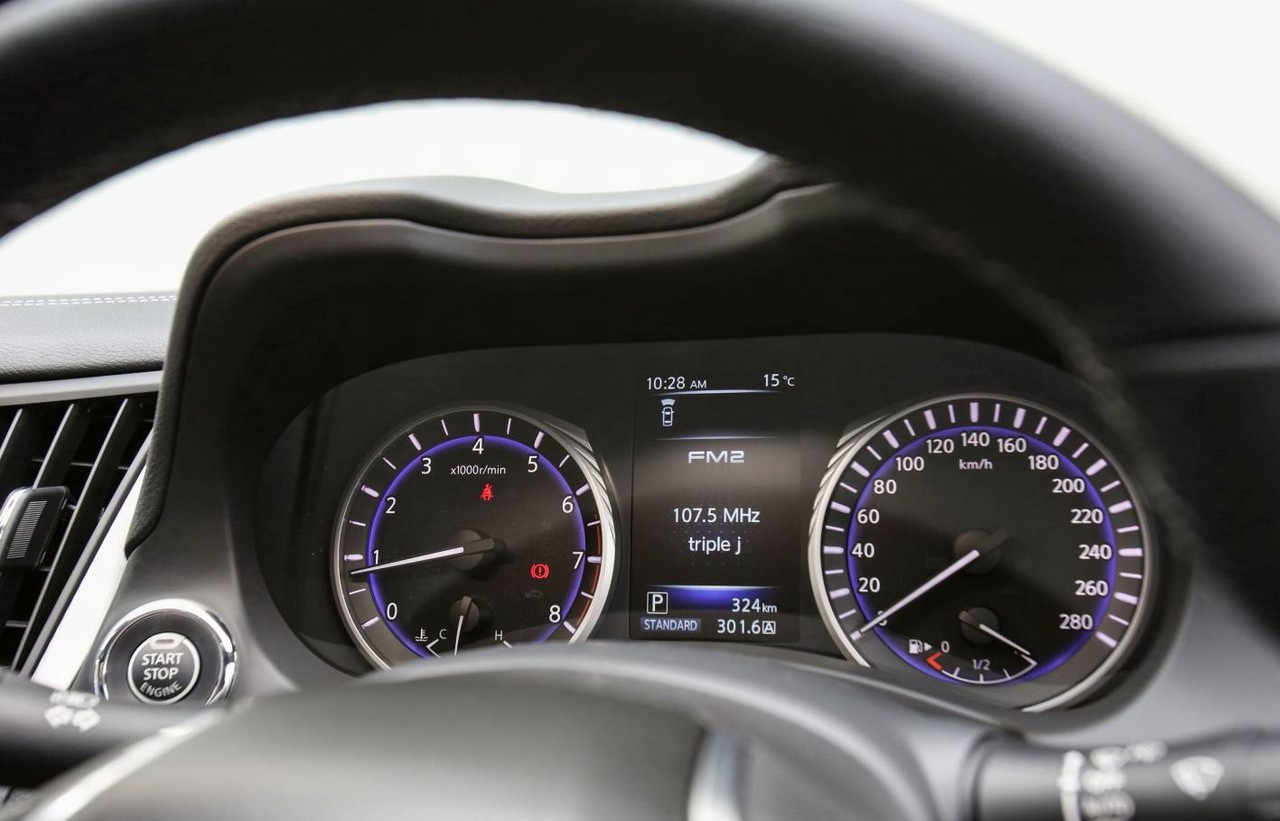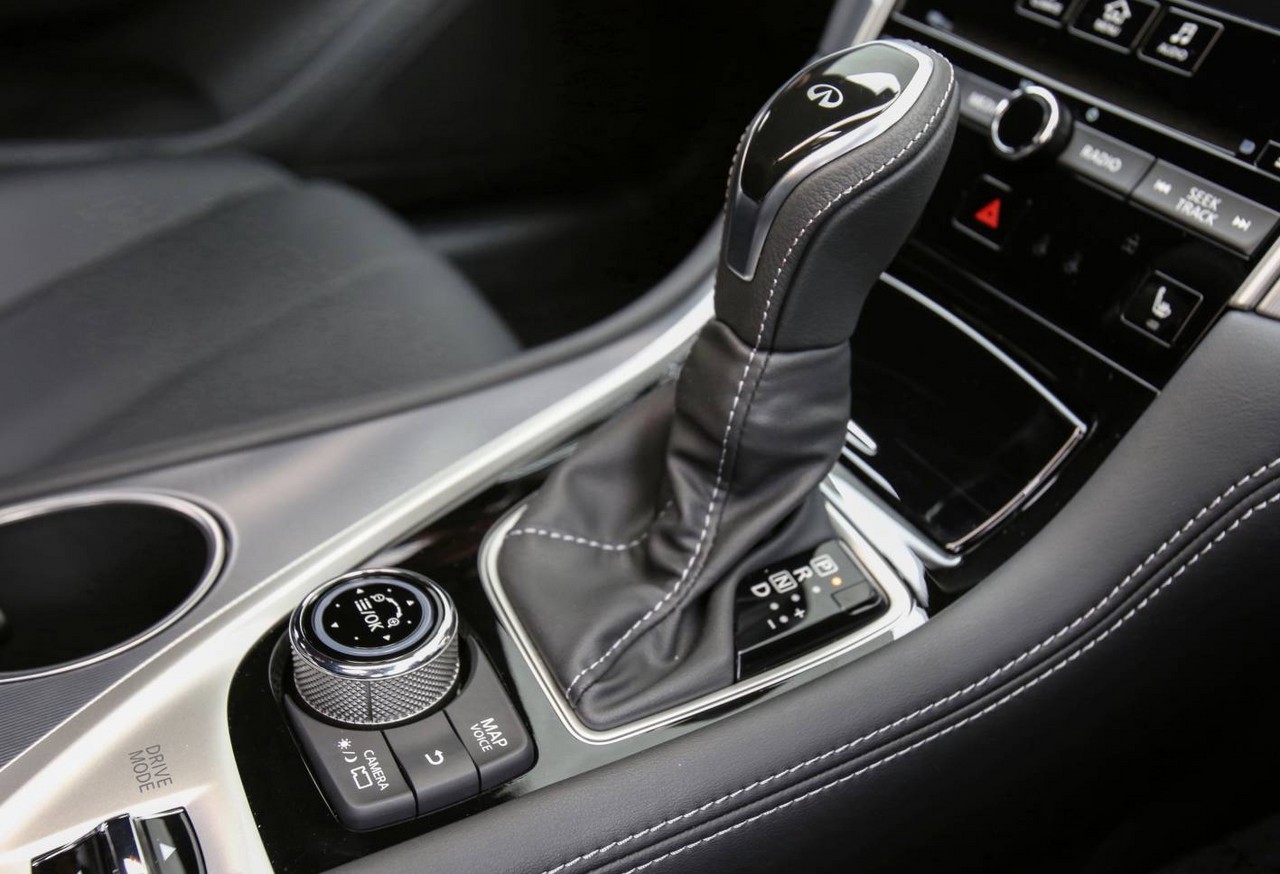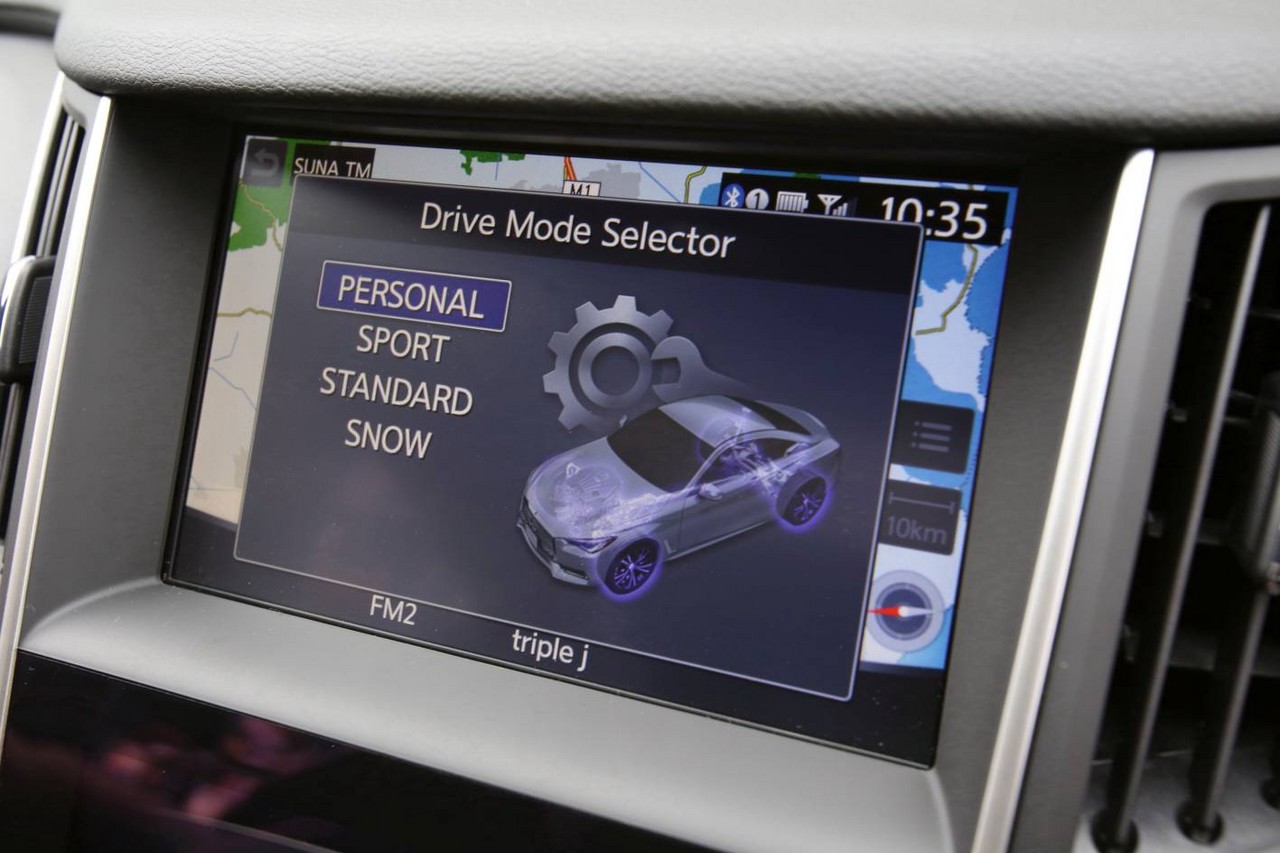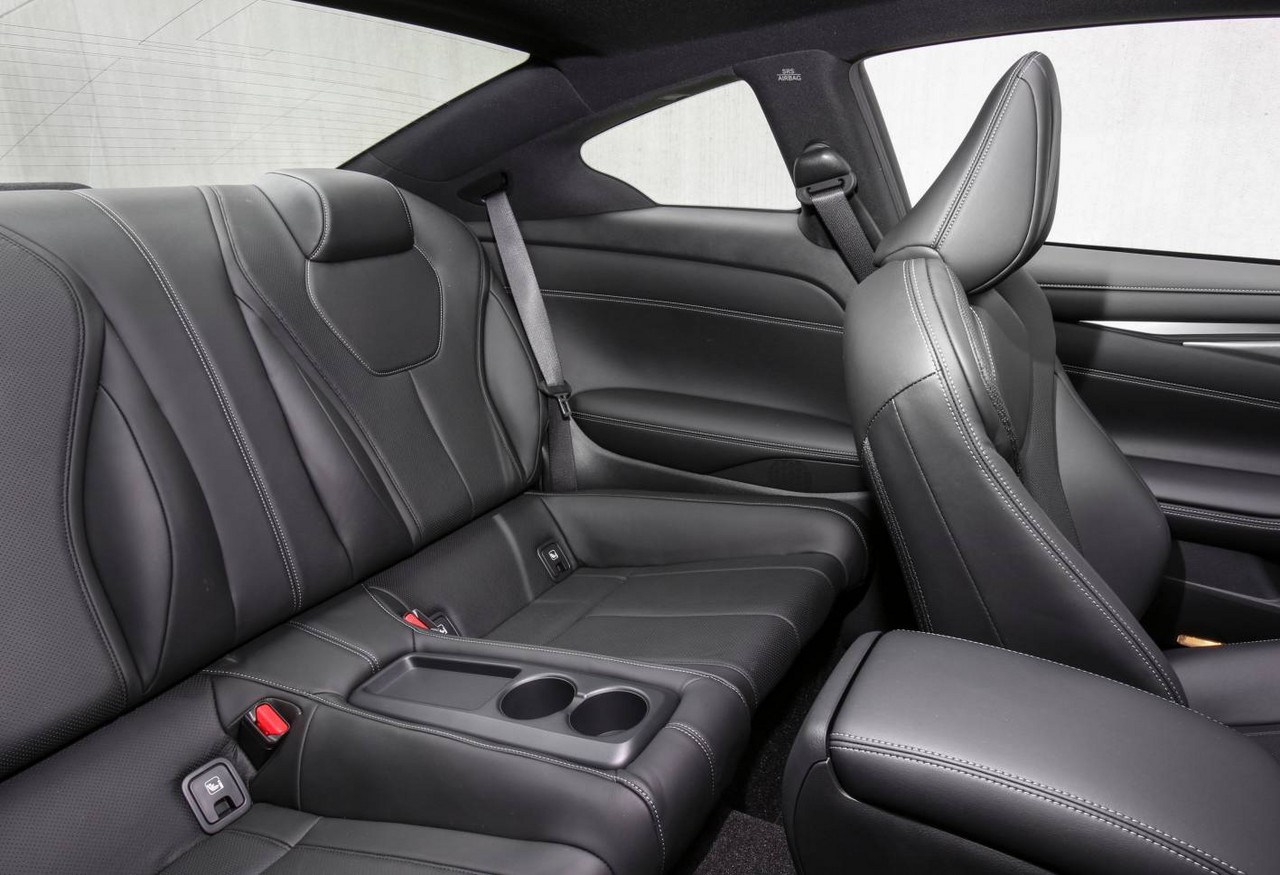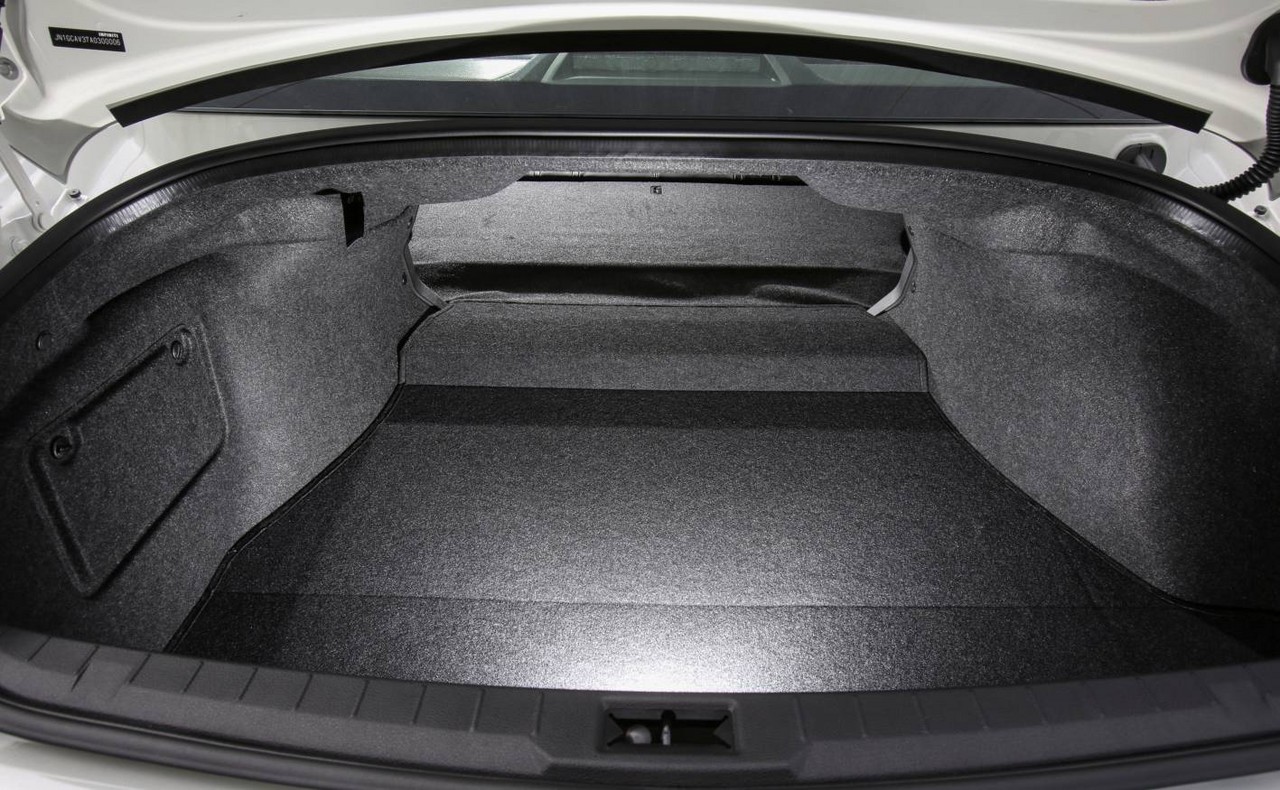
- Impressive ride/handling balance
- Powerful biturbo VR30DDTT V6 engine
- Generally spacious rear seats…
- … but not for headroom
- Direct Adaptive Steering is overly sensitive around centre
- Nissan-derived switchgear at odds with premium pricing
- InTouch infotainment system is difficult to use
- Bewildering array of personalisation settings
- Infiniti Q60 GT cannot be specified with safety equipment that is available on the Infiniti Q50
Overview
Commencing production in August 2016 and officially released in Australia in November 2016, the Infiniti V37 Q60 was a two-door coupe. Manufactured in Tochigi, Japan, the rear-wheel drive Infiniti Q60 Coupe was initially offered with a 2.0-litre turbocharged petrol engine and in GT editions.
In March 2017, the Infiniti Q60 Coupe range expanded with Sport Premium and Red Sport editions, the latter powered by 3.0-litre biturbo V6 petrol engines. In August 2018, however, the Q60 Coupe range was reduced and the ‘GT’ edition was renamed ‘Pure’.
Infiniti Q60: M274 and VR30DDTT engines
For the Infiniti Q60 2.0t, the 2.0-litre Mercedes-Benz M274 petrol engine had an aluminium alloy block and cylinder head, a hollow crankshaft, a single-scroll IHI (ICSI) turbocharger, double overhead camshafts (chain-driven), variable camshaft timing (hydraulically controlled), four valves per cylinder, direct fuel injection via piezo-electric injectors and a compression ratio 9.8:1. Furthermore, the M274 engine had a 6300 rpm redline. To reduce fuel consumption, the M274 engine had a start-stop function which enabled it to shut down when the Infiniti Q60 was stationary in traffic; over the combined ADR 81/02 test cycle, fuel consumption for the Infiniti Q60 2.0t is 7.7 litres per 100 kilometres.
For the Infiniti Q60 3.0t, the 3.0-litre VR30DDTT biturbo V6 petrol engine had an aluminium alloy block with an arc sprayed mirror coating for the bores, an aluminium alloy cylinder head with integrated exhaust manifold, double overhead camshafts (chain-driven), four valves per cylinder, variable intake and exhaust valve timing (electronically and hydraulically controlled, respectively), direct fuel injection, water-to-air intercoolers and electronic wastegate actuators. For the 298 kW VR30DDT engine, the turbochargers had turbine speed sensors and peak boost pressure was limited to 14.7 psi.
Both engines were mated to seven-speed automatic transmissions which featured Infiniti’s ‘Adaptive Shift Control’ (ASC). In addition to adaptive to driver behaviour, ASC included a lateral acceleration sensor to detect topographical changes in the road – such as hills or corners – and enhanced gear-select patterns according to the conditions.
| Edition | Years | Engine | Trans. | Peak power | Peak torque | |
|---|---|---|---|---|---|---|
| 2.0t | GT | 2016-18 | 1991 cc M274 turbo petrol I4 | 7sp auto | 155 kW at 5500 rpm | 350 Nm at 1500-3500 rpm |
| Pure | 2018-19 | |||||
| Sport Premium | 2017-18 | |||||
| 3.0t | Red Sport | 2017-19 | 2997 cc VR30DDTT biturbo petrol V6 | 7sp auto | 298 kW at 6400 rpm | 475 Nm at 1600-5200 rpm |
Body and dimensions
Like the Infiniti V37 Q50 , the Q60 Coupe was underpinned by Nissan’s FM platform. Compared to the Q50 sedan, the Q60 Coupe was 98 mm shorter (at 4685 mm), 26 mm wider (1850 mm) and 48 mm lower (1395 mm), though wheelbase length was unchanged at 2850 mm. Furthermore, the Q60 Coupe had luggage capacity of 342 litres.
The Infiniti V37 Q60 2.0t had a drag coefficient of 0.29 Cd, though models with V6 engines had an Active Grille Shutter that was normally closed to reduce aerodynamic drag but opened when additional cooling is required. As a result, it is understood that the Infiniti Q60 3.0t had a drag coefficient of 0.28 Cd.
Unusually, the bootlid for the Infiniti Q60 was a hybrid combination of a resin skin on a steel frame. According to Infiniti, this provided greater freedom to develop shapes from a single part.
Suspension
The Infiniti Q60 had single pivot, double-wishbone front suspension and independent, multi-link rear suspension with coil springs. The Infiniti Q60 3.0t Red Sport, however, had ‘Dynamic Digital Suspension’ which consisted of electronically-controlled shock absorbers and enabled the driver to select from various drive modes. Furthermore, the Infiniti Q60 3.0t had a 10 mm lower ride height than the Infiniti Q60 2.0t.
Steering: Rack EPS and Direct Adaptive Steering
As standard, the Infiniti Q60 had rack-and-pinion steering with electric power assistance (Infiniti’s ‘Rack EPS’). Beyond this, the Infiniti Q60 3.0t Red Sport had Infiniti’s ‘Direct Adaptive Steering’ (DAS), an electronic steer-by-wire system. With DAS, the driver’s steering wheel inputs were electronically transferred to the front wheels by a high-response actuator which drove the steering rack. By eliminating mechanical losses that could slow the responses (as occurred in conventional systems), steering response was faster and steering wheel vibrations were eliminated. Furthermore, the driver had the ability to adjust both steering weight and directness (i.e. the steering gear ratio) via a touch screen as part of the ‘Infiniti Drive Mode Selector’. DAS also included a triple-mode back-up (three separate electronic control units) and a mechanical steering linkage as a failsafe.
Safety equipment
Standard safety equipment for the Infiniti Q60 included dual front airbags, front side airbags, full-length curtain airbags, ABS, electronic brake force distribution, brake assist, electronic stability control, traction control, active front seat head restraints and front seatbelts with pre-tensioners and load limiters.
As standard, the Infiniti Q60 Coupe was equipped with Infiniti’s Predictive Forward Collision Warning (PFCW) and Forward Emergency Braking systems which used a radar sensor located behind the front bumper to alert the driver if there was a potential risk of a forward collision. When this occurred, a warning tone would sound and the ‘Vehicle Ahead Detection’ indicator light would illuminate. If active, the Forward Emergency Braking system applied upward pressure on the accelerator pedal to alert the driver and provide partial braking. If the driver did not respond, additional audible and visual warnings were issued and greater braking force would be applied.
As standard, the Infiniti Q60 Coupe also had a pop-up bonnet which, in the event of a pedestrian collision, uses a pyrotechnic charge to raise the trailing edge of the bonnet for a larger buffer between the bonnet and the top of the engine.
Compared to the Q60 GT, the Q60 2.0t Sport Premium and 3.0t Red Sport were equipped with the following items –
- A pre-crash function for front seatbelts which used a motor to tighten the seatbelts to restrain the occupants in the event of emergency braking, sudden steering manoeuvres, activation of the Intelligent Brake Assist system or when a rollover was anticipated;
- Intelligent Cruise Control (ICC): enabled the driver to specify the desired speed and distance to the vehicle ahead. If the vehicle ahead slowed, ICC would automatically brake the vehicle to maintain the distance and resume the desired cruising speed when the vehicle ahead accelerated;
- Back-up Collision Intervention (BCI): could detect stationary objects and crossing traffic behind the vehicle and warn the driver via an audible tone and flashing light. If the driver failed to respond, the system would apply upward pressure on the accelerator pedal and momentarily apply the brakes to alert the driver;
- Blind Spot Warning (BSW) and Blind Spot Intervention (BSI): provided visual and audible warnings if another vehicle was detected in the blind-spot area (BSW). If the driver ignored the warning and attempted to steer into the other vehicle’s path, the brakes would be automatically applied on the opposing side of the vehicle to return the vehicle to its lane (BSI); and,
- Lane Departure Warning (LDW) and Lane Departure Prevention (LDP): a camera mounted near the rear view mirror would detect lane markers and whether the vehicle was drifting into another lane without indicating. A warning tone would initially sound, followed by autonomous braking of the wheels on the opposing side of the vehicle if the vehicle continued to drift.
Brakes
The Infiniti Q60 2.0t had 320 mm by 28 mm ventilated front disc brakes with twin-piston callipers and 308 mm by 16 mm ventilated rear discs with single-piston callipers. The Infiniti Q60 3.0t Red Sport, however, had an Akebono performance braking package which consisted of 355 mm by 32 mm ventilated front brake discs with four-piston callipers and 350 mm by 20 mm ventilated rear discs with two-piston callipers.
Features: Infiniti Q60 2.0t GT
As standard, the Infiniti Q60 GT was equipped with Infiniti’s ‘InTouch’ infotainment system which included dual display screens (an eight-inch upper and seven-inch lower display) and satellite navigation with SUNA live traffic updates. Furthermore, Infiniti’s ‘Drive Mode Selector’ (DMS), enabled the driver to select from four drive modes – Standard, Snow, Sport and Personal – via the eight-inch touchscreen. Of these,
- ‘Standard’ provided normal engine output and transmission settings, greater steering assistance and, at higher speeds and over rough road surfaces, a slower steering gear ratio;
- ‘Sport’ reduced steering assistance, provided a faster steering ratio, greater accelerator pedal response and more aggressive transmission mapping;
- ‘Personal’ enabled the driver to customise steering settings (from Standard and Sport) and accelerator pedal response (Default and Dynamic); and,
- ‘Snow’ reduced engine outputs and engages higher gears to reduce wheel spin on slippery roads.
Other standard features for the Infiniti Q60 2.0t GT included 9.0J x 19-inch alloy wheels with 255/40 R19 runflat tyres, a six speaker sound system with CD player (MP3-compatible), USB connection ports, Bluetooth mobile phone connectivity and audio streaming, dual-zone climate control air conditioning, cruise control with speed limiter, high-bolster seats with semi-aniline leather faces, eight-way power adjustable and heated front seats, LED headlights with adaptive lighting and high beam assist, LED front fog lights, daytime running lights, dusk-sensing headlights, rain-sensing wipers, a rear view monitor, flat folding rear seat backs, a leather-wrapped steering wheel, remote central locking with proximity key, power adjustable and folding door mirrors with heating and automatic tilting on reverse, power windows, a power adjustable steering wheel (tilt and telescopic adjustment) with memory settings, an auto-dimming rear view mirror, illuminated vanity mirrors, ambient lighting, tyre pressure monitoring, a trip computer and an immobiliser.
Features: Infiniti Q60 2.0t GT with Enhancement Pack
For the Infiniti Q60 2.0t GT, the optional Enhancement Pack added a ‘Bose Performance Series’ audio system which had thirteen speakers, including multiple 10-inch speakers, 6- by 9-inch woofers and a lightweight silk dome tweeter. The Bose audio system also included an ‘Active Noise Control’ function which microphones to detect low frequency noises and emit reverse phase audio signals through the door-mounted speakers to counteract them.
Features: Infiniti Q60 2.0t Sport Premium and 3.0t Red Sport
Compared to the Q60 2.0t GT, the Q60 2.0t Sport Premium and 3.0t Red Sport were distinguished by their 19-inch dark chrome alloy wheels with R19 94W run-flat tyres, the Bose Performance Series audio system (described above), steering wheel gearshift paddles, power sliding glass sunroof with sliding sunshade and carbon fibre interior trim.
Furthermore, the Infiniti Q60 2.0t Sport Premium and 3.0t Red Sport both had:
- Around View Monitor (AVM) with Moving Object Detection (MOD): AVM was a parking aid which provided a virtual video image of the vehicle with surrounding objects, including moving objects; and,
- Adaptive Front-lighting System (AFS) with High Beam Assist: included self-leveling headlights and, when travelling at speeds of 35 km/h and above, automatically turned off the high beams in the presence of oncoming traffic.
From August 2018, the Infiniti Q60 3.0t Red Sport was equipped with 20-inch alloy wheels.
Brochure
- Brochure: Infiniti V37 Q60 Coupe (November 2016)
- Brochure: Infiniti V37 Q60 Coupe (April 2017)
- Brochure: Infiniti V37 Q60 Coupe (August 2018)
